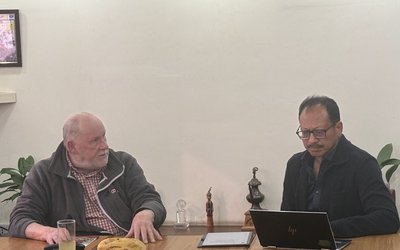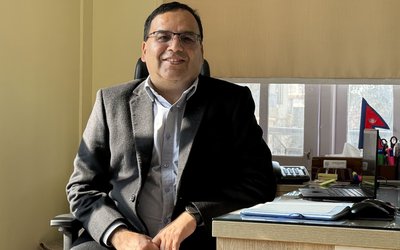More on Interview






As Nepal is celebrating the Civil Service Day amidst growing confusions, BEGENDRA RAJ SHARMA PAUDYAL Joint secretary and spokesperson of the Ministry of General Administration, spoke to New Spotlight on various issues regarding the state of civil servants in Nepal.
What is the importance of celebrating the Civil Service Day?
Although it is a ritual, we are working now to make it different from the past. Of course, the civil servants will hold rallies and formal programs, such as to award best civil servants. The Prime Minister will attend the program. There will be sports and other competitions.
Don't you think the time has come for the ministry to celebrate it with really differently?
Yes. The time has come now. As civil servants, we need to show the people that we are the servants of the people and we are there to help and deliver things.
What is the number of civil servants now?
There are a total of 95,599 civil servants. There are altogether 79,763 permanent civil servants currently working in the country and this number also includes 15,702 from Health services. Of the civil servants, 5,841 are females. There are 13,440 gazetted officers, including 946 females. The gazetted class include 52 special classes, 492 first class, 3,021 second class and 9,875 third class. There are two female special classes, and 12 first class, 107 second class and 825 third class female members.
What is the number of non-gazetted officials?
Out of 29,143 total non gazette staff, 3,356 are female. There are 13,850 non-gazetted first class, 12753 second class, 2092 third class, 434 fourth class and 14 fifth class officials. Out of 21,344 class, 1,539 are females. Out of the total employees, there are 15,702 in the health sector with 5,972 females. Likewise, there are 129, including 2 women, in the judiciary.
What is the number of temporary, contract and daily wages staff?
Although the government has stopped recruiting the permanent position at class level as the current Civil Service Act bars such recruitment, the government is now hiring office helpers, including drivers and peons in contract.
Where is the highest number of civil servants?
There are 19,451 civil servants in Kathmandu valley and 60,129 outside the valley. Kathmandu District has the highest concentration of civil servants, with 15,261 and Manang district has the lowest, with288 civil servants.
How do to see the present state of civil service?
Nepal's civil service has gone through various stages to reach the present state. In more than seven decades of history, several high level administrative committees were set up to streamline the civil service. Tanka Prasad Acharya, Dr. Bhekh Bahadur Thapa, Bedananda Jha to Girija Prasad Koirala and, the last time, Pampha Bhushal headed high level committees which recommended ways to reform the civil service. Our ministry is concerned how to implement the suggestions and recommendations given by all these committees. I don't have any hesitation to say that we are behaving as if we are not servants but masters as far as the issues of service delivery are concerned. The time has now come to change this mentality. For this we have to change our behavior.
What is the role of the Ministry of General Administration?
One of the main functions of the Ministry of General Administration is to take reform initiatives in the civil service. Civil service reform and the Ministry of General Administration are supplementary and complimentary to each other. Our role is not only the administrative management but also reformation of civil service. This is a very broad term as it involves personal administration and public administration. The aim of public administration is to improve the service delivery to the public. The administrative reform process began in 2009 BS. It was institutionalized on the basis of recommendations given by Tanka Prasad Acharya. The issues related to administrative reforms involve a range of offices from the president’s office to ward office of the Village Development Committee. The reform does not mean to reform big things. Reform needs to start from you.
Do you think the government of Nepal has ever implemented the reform agenda?
We have constituted various high level commissions and committees. However, their recommendations are now locked in the boxes. People are raising fingers at us due to the failure to deliver prompt services to the people. There is an accusation that politicians and civil servants are standing side by side to exploit the people. In this context, it is the responsibility of all the concerned parties, including Nepal Government, Cabinet Secretariat and Ministry of General Administration to initiate reforms to address the issues raised by the people.
Trade unions are reportedly destroying the norms in civil service. How do you look at this?
The Ministry is seriously looking at the issues of trade unions in civil service and the reasons behind the failure of the government's delivery system and reform initiatives. Political leadership must decide what kind of reforms it wants. We have the technical capability to initiate the reforms. We must reform the civil service by keeping in mind that civil service should work to provide effective service to the common people.
Civil servants are criticizing the Ministry of General Administration for being inefficient and incapable. How do you look at this?
You cannot change things by criticizing and condemning the Ministry of General Administration. Civil servants should raise fingers against the bad precedents and practices of the Ministry. Civil servants working in the Ministry cannot undertake big reforms. What is required is the political commitment and political guidance to take any initiative. Political commitment and determination of high level civil servants can make real changes possible. One of the bitter realities is that no political leader considers the Ministry of General Administration as the best Ministry. Instead, it is always receiving the least priority for them.
How can we make the Ministry of General Administration more effective now?
As long as this ministry remains a jumping pad, nothing will change in the Ministry and civil service. This is a very important Ministry and it needs the support of the prime minister, chief secretary, secretaries, trade unions and civil servants as well. If there is anything wrong in this ministry, it will have implications in all levels. We are first public servants, and then we are the civil servants, and only after that we are the members of particular trade union. In practice, the opposite exists. First, a civil servant considers himself as a member of particular political party, then the member of particular trade union and only after that they consider themselves the civil servants. It is that a member of particular trade union does not have to work.
How do you see the role of Nepal's development partners?
Nepal's development partners have been supporting civil service reform program for the last many years. From India to Britain and multilateral agencies like Asian Development Bank, the World Bank, and the IMF have also supported Nepal's civil service reform. Their support is for institutional capacity building. We took foreign aid in all different areas, including in the capacity building of cabinet secretariat and judiciary.






